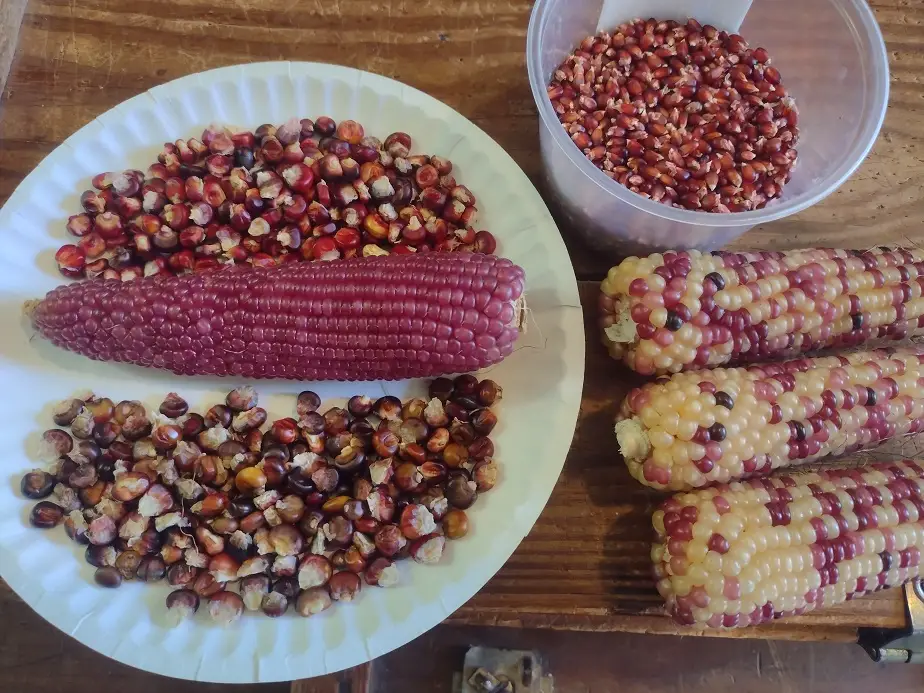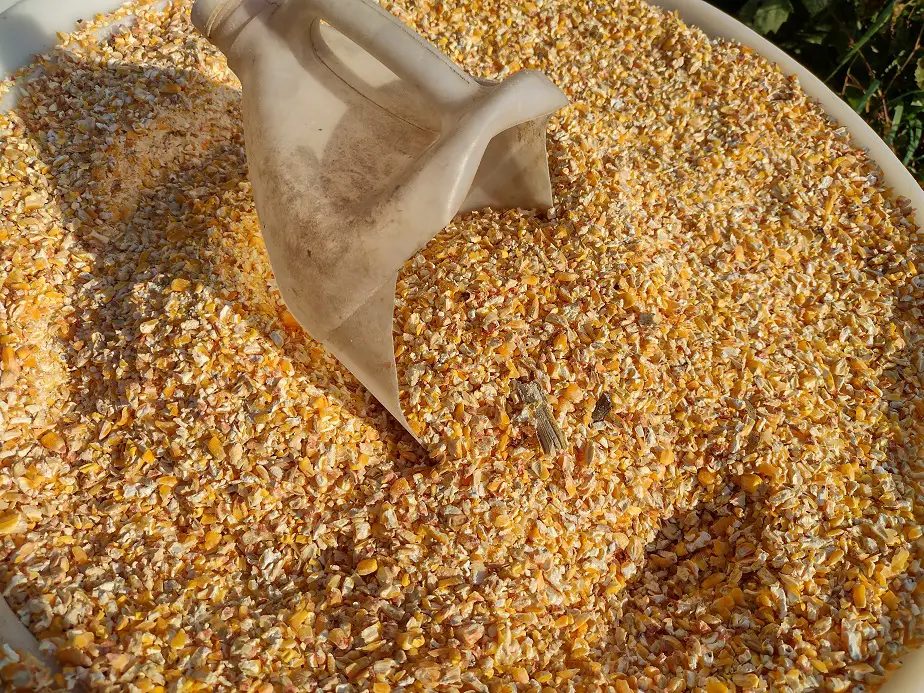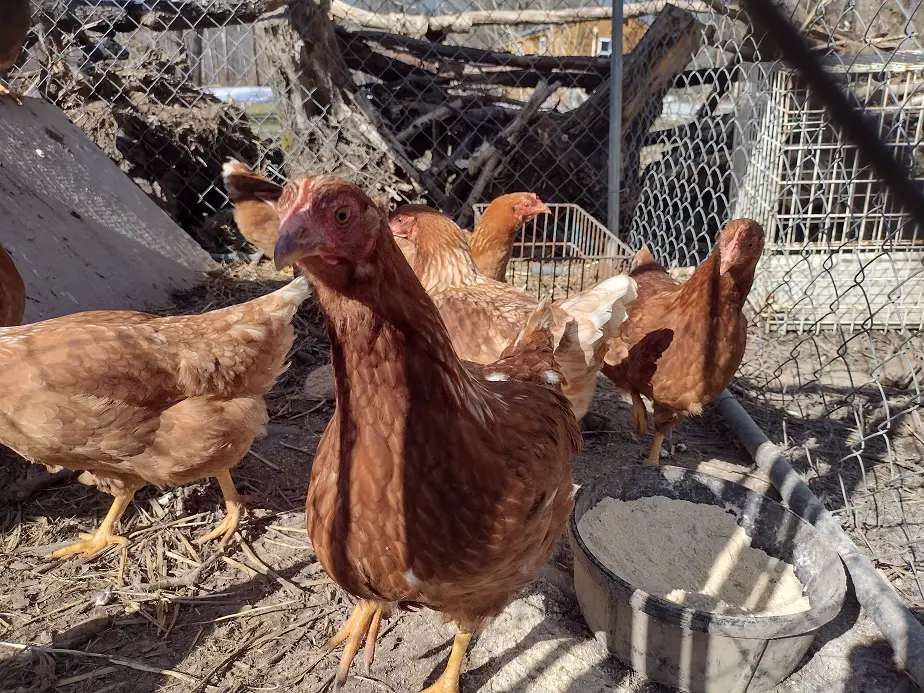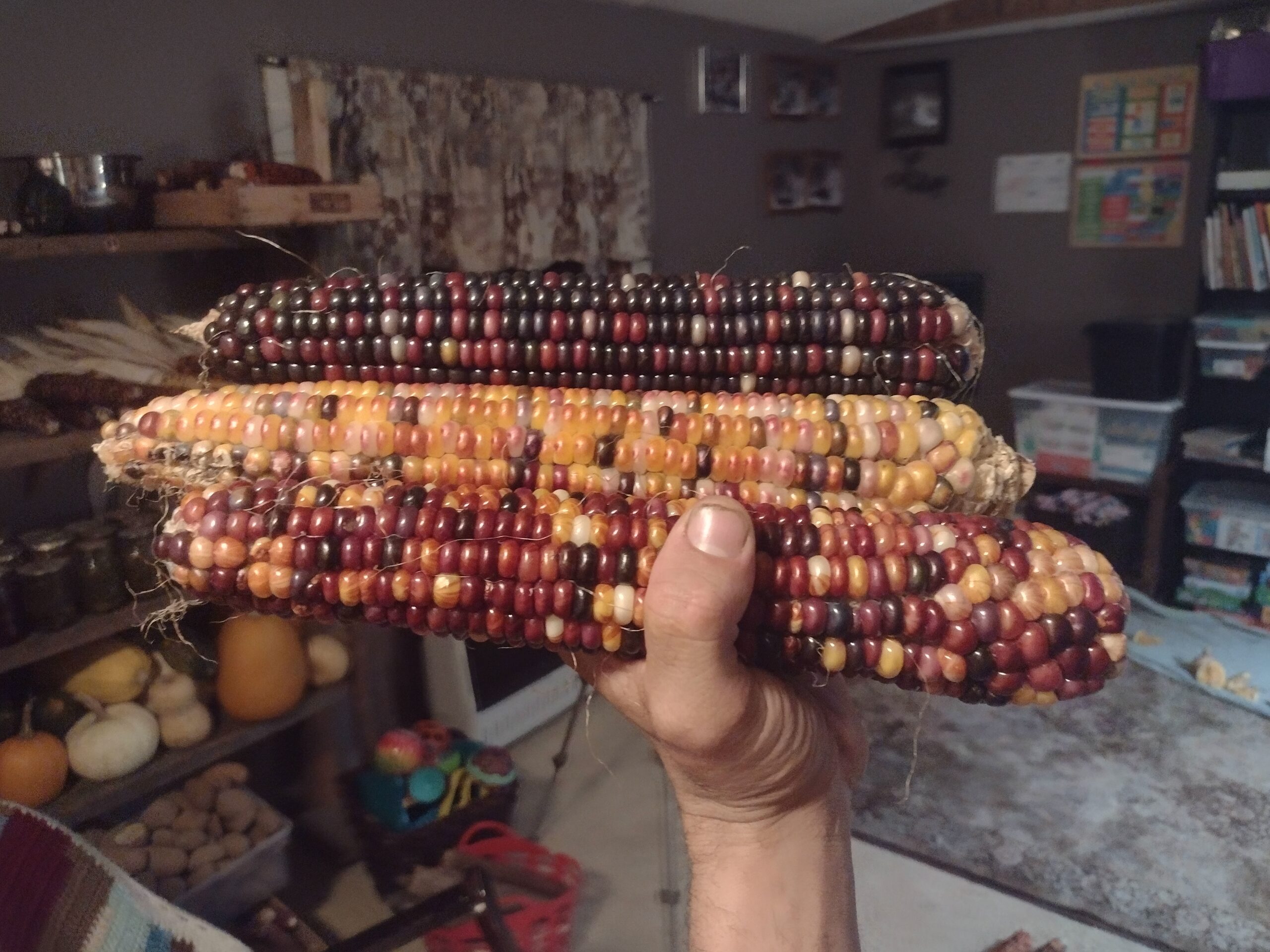In a time when everything is just yellow corn, is it all that great?
The best grains for chicken feed are organically grown wheat, oats, barley, and Amaranth. They are the most nutritional, have a high protein content, and are fairly productive to grow. Some flint corn varieties are also exceptional for chicken feed, being high in protein, slow-digesting starch, and antioxidants.
A question like this gets deep, and goes against the status quo. Let’s jump in.

Oats
Before the corn craze, oats were the crop of choice for chicken feed. Oats are higher in protein, and have a tough fibrous husk that chickens can easily digest. Most oats are around 12 percent protein while modern field corn is 7-8 percent protein. I would say that oats are better than regular corn.
We feed a lot of oats to our birds. Not a hulled oat, but oats with the husk on. Sometimes it’s called groats. I get it straight from the farmer. When our birds are eating a lit of it, it shows. Some of the fiber passes through and is evident.
The whole oats are less likely to make a chicken fat than corn because of its extra fiber. The only one downside, nutritionally speaking, is that oats have a bit of tannic acid. Darker grains usually have it. Tannic acid is called an anti-nutrient because it slightly lessens overall digestion.
We circumvent that by soaking the oats in water for a day. That ferments the grain and causes the tannic acid to break down. I do recommend fermenting grains of any type for your chickens. It makes all grains more nutritionally balanced and easier to digest.
Wheat
Wheat is arguably the best grain for chickens commonly available in the US. It has up to twice the protein of corn and is just as easily digested. It is a great base for chicken feed. A hard variety wheat has more protein and overall nutrition than a soft variety.
Some experts worry about feeding hard variety wheat to chickens. Hard starch digests slower and is more dependent upon bacteria in the lower gut to break it down. The worry here is that it could cause stickier feces, which could create a cleanliness problem in laying hens. It’s not a concern if fermented.
Wheat is higher in protein, but it can very from between 10-1/2 and 15 percent, depending on the variety. Wheat usually has around 0.3 and 0.4 percent lysine. That’s near double what most corn has.
Barley
Barley is high in protein and commonly used in chicken feed, but it possesses anti-nutritional factors that need to be addressed. Enzymes are often added to barley to aid in digestion, but fermenting the grain seems to work better. Barley is a high-fat, high-protein, high-fiber grain with good feed potential.
Barley has more calories, pound for pound, than corn and wheat. That’s due to the fact that it’s higher in fat. It’s got darn near 20 percent fiber and has less starch than the other grains. Because it’s high in fiber, it’s not used a lot for poultry in the US. However, it’s commonly used in Cannada and Europe.
Once again, a simple fermentation, literally soaking it in water until it starts to bubble (24 hours at room temperature) will greatly increase the protein, nutrition, and overall digestibility of the grain. Barley used to be a very common grain for chickens and for pigs, but was replaced by corn when corn became cheap.

Flint Corn
Flint corn is an exceptional grain choice for chickens. It’s a good combination of starch and protein without too much fiber. Flint corns are 25-50 percent higher in protein than common dent corn, and are generally higher in phytonutrients like beta-carotene and anthocyanins.
Flint corn is like hard wheat, it’s higher in hard starch. Because of this, flint corn (which includes popcorn) is a slower-digesting grain with few anti-nutritional properties. Studies have shown chickens fed flint corn to gain weight better and be healthier. This is my preferred grain type for chicken feed.
The flint corn that I’d recommend would be of a darker or bolder color, or a multi-color like indian corn. Phytonutrients are pigments that are highly nutritionally beneficial. The best of them are beta-carotene and anthocyanin. Both are very potent antioxidants with deep health benefits to animals.
The best variety for beta-carotene is Atomic Orange. It’s a softer flint corn. so it digests a bit easier than most. It’a a deep orange color, showing it’s high beta-carotene content. It has around 12 percent protein. It just may be the nutritionally best grain for chickens out there. I’ve yet to find an arguably better one.
It’s just not as productive as modern GMO field corn. Nothing really is.
Anthocyanin is a blue to purple pigment in corn, and in the strongest concentrations, it looks black. It’s also found in red corn. We have been growing Wade’s Giant Indian corn because it has a good bit of red, blue, purple, and black hues to it. I’ve been breeding it for higher Anthocyanin content.
Amaranth
Amaranth grain has 15-18 percent protein and about 1 percent lysine, making it a complete protein source for chickens. When vitamins and minerals are added, it can be one of the better feeds available, nutritionally speaking. It’s generally a red hue, giving it anthocyanins.
Its downside is that it’s not at all productive, yielding only 1/4 as much feed as a good field of corn per acre. Amaranth grain usually yields around 25-50 bushels per acre, about as productive as most shelled beans. But, those beans have twice or more the protein levels.
I would have included beans but they’re not usually considered a grain. If you want to grow feed for chickens, any sort of bean would be a pretty good choice. I know most animal feeds have soybean, but beans like kidney, pinto, and black bean are also great for chickens and don’t have GMO concerns.
Peas are also a fine choice in some areas. They like cooler weather and have a short growing season compared to most grains and beans. I know that most people reading this article are probably more interested in buying a fine feed or quality grain for scratch, but myself, I want to grow it.
It’s a big part of us being a more sustainable and resilient farm operation. It’s just hard to do on an acre. Hopefully, our money-saving and penny-pinching will let us purchase a larger piece of land in the near future. Anyways, back to chicken grains.

What Makes a Grain Good for Chickens?
A good grain for chickens needs to cover their caloric needs in a balanced way. It should have a good balance of the four main nutrients for chickens: starch, fiber, protein, and fat. Taking things one step further, it should be nutritionally dense in phytonutrients, primary minerals, and essential vitamins.\
Corn is the most common grain for chickens. The common corn is a GMO number 2 yellow dent corn. It’s high in starch, has decent fat content, and is low in most everything else. It’s used because it’s cheap, thanks primarily to government incentives to grow it and to price-fixing games. Plus, GMO usually means 25 percent greater yields.
That corn makes up about 80 percent of most chicken feeds. Grain should make up the bulk of chicken feed. It’s what’s good for them. They need it. But, there are better options for the chickens, nutritionally speaking.

Is GMO Bad for Chickens?
GMO grain may be bad for chickens. Research is a bit unclear on this, but it is proven that GMO grains in chicken feed can affect the health of people who eat the eggs and meat. This is newly emerging information, but it has led several countries to outright ban all GMO crops.
The popular GMO varieties of grains are weed killer-resistant, known as Round-UP Ready, allowing a much heavier use of herbicide, specifically glyphosate, in fields and even directly on crops. This is shown to cause gastric problems, food sensitivities, gluten intolerance, and chronic digestion discomfort.
Glyphosate, aka round-up, is somewhat an anti-microbial. In trace amounts, it’s known to kill over 50 percent of the beneficial types of microbes in a healthy human gut. That’s got some big potential ramifications.
It’s also strongly linked to immune system deficiencies and allergies, particularly food allergies. There has been a lot of concern, and several studies suggesting, that it’s possibly responsible for an increase of cancers as well.
Is Corn Good For Chickens?
Corn is a fine whole grain for chickens. It’s generally cheaper and has overall decent nutrition. Research shows that brightly colored corn and flint corn varieties are more beneficial than common field corn.
I know that corn-free chicken feed is a thing, mainly due to health concerns about corn. It’s really about GMO concerns. Around here, the cleanest fields of corn are grown by the Amish. my local feed mill sells “Amish chicken Feed”, which is made with corn, peas, and beans grown by local Amish.
It’s a completely organic (not certified organic though), and non-GMO feed. I see more and more of it selling all the time.
Related Articles:

